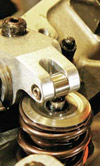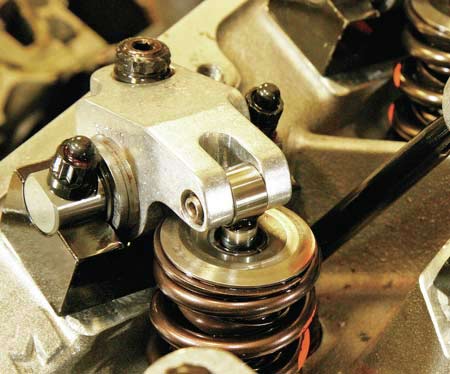The importance of natural frequencies
 Some of the recent articles concerning pushrod valvetrains have tried to explain the importance of valvetrain stiffness. The advent of the Spintron tester, and its widespread deployment in the r&d shops of engine builders, has given engineers a better insight into valvetrain behaviour, especially the deviation from the 'theoretical' valve lift curve we might expect the lifter/pushrod/rocker to impart to the valve.
Some of the recent articles concerning pushrod valvetrains have tried to explain the importance of valvetrain stiffness. The advent of the Spintron tester, and its widespread deployment in the r&d shops of engine builders, has given engineers a better insight into valvetrain behaviour, especially the deviation from the 'theoretical' valve lift curve we might expect the lifter/pushrod/rocker to impart to the valve.
Anything that doesn't behave as an infinitely stiff member (which means everything) will affect the motion of the head of the valve. In the time since Spintron rigs have been widely used, the importance of pushrod stiffness has been understood, with the result that pushrods have grown in cross-section (and mass) in order to increase stiffness. The limiting factor in some cases is now the available space in which the pushrod can articulate.
One important component that isn't part of the fundamental opening mechanism, but which does a very important job in closing the valve, is the valve spring. The problems with resonance of springs are well known and have been widely documented. The most recent article on valve springs in Race Engine Technology magazine (issue 54) has a number of references, one of which by RR Tatnall* makes for worthwhile reading.
In order to avoid the phenomenon of spring resonance - often referred to as spring surge - we need to avoid the natural frequency of the spring. When this is calculated, we will find that it is very much higher than the operating speed of the engine. The reason here is that we need to avoid the lower cam profile harmonics that could excite the spring, causing it to surge. With sufficient knowledge of our cam profile we can certainly do this.
So, how are pushrods involved in this? Well, choosing an incorrect pushrod stiffness can also excite valve springs. When the pushrod vibrates, as it is wont to do when struck at its lower end, this can excite the valve spring and send it into surge. We need to take care to calculate all the significant natural frequencies for the pushrod to ensure we don't get ourselves into a pickle with spring resonance. Maintaining the engine at the speed at which excitation occurs would lead to a very rapid mechanical failure.

The pushrod, in common with everything else, has more than one natural frequency, and more than one fundamental mode of vibratory movement - it can vibrate torsionally, longitudinally and laterally (bending). Each of these will have more than one natural frequency, with different 'mode shapes' depending on the order of vibration. Anyone with access to a finite element analysis package, and who hasn't tried this before, would find it interesting to look at the natural frequencies and vibration modes of this simple component.
In designing the pushrod for our race engine, we need to have an eye not only on providing sufficient stiffness to help with valve control, we also need to be mindful of the natural frequencies of vibration and how these will interact with the valve spring.
Reference
* Tatnall, R.R., "Fatigue of Helical Springs", ASME Proceedings of Spring Meeting, 1940
Fig. 1 - The interaction between pushrod and valve spring is critical. Incorrect choice of pushrod stiffness can lead to destructive spring surge
Written by Wayne Ward